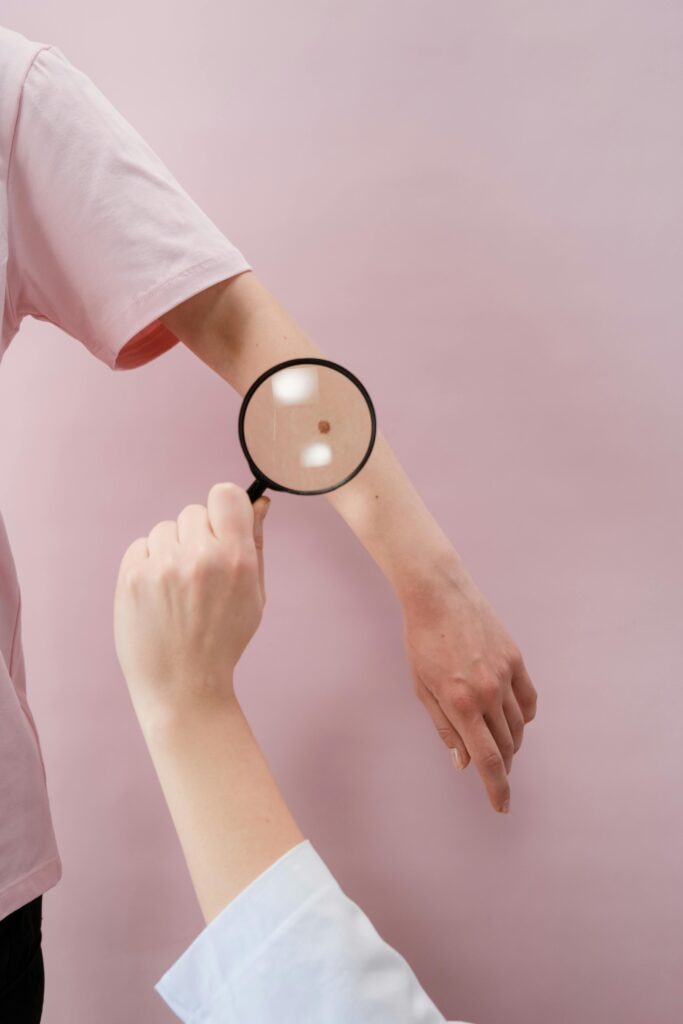August is Skin Cancer Awareness Month, a timely reminder to check your skin, schedule annual screenings, and act if you notice any suspicious moles or lesions. While mole removal is a common and often simple procedure, individuals living with diabetes need to be aware of the additional risks involved, especially when it comes to wound healing.
Research has shown that people with type 2 diabetes may be at increased risk for certain types of skin cancer, including basal cell carcinoma and squamous cell carcinoma. For diabetic patients, the removal of a mole isn’t just a routine dermatologic procedure, it can pose a higher risk of complications if the wound is not properly treated.
Why Skin Checks Matter
Skin cancer is the most common form of cancer in the United States. While many cases are treatable, early detection is key. A recent study published in Cancers (Basel) noted that individuals with type 2 diabetes have a statistically significant association with non-melanoma skin cancers. This makes regular skin checks and prompt mole evaluation especially important for diabetic patients.
How Diabetes Affects Wound Healing
When a mole is removed, either through shaving, surgical excision, or punch biopsy, the body begins the natural process of wound repair. For individuals with diabetes, however, that process can be slower and more complicated.
Multiple studies, including those from the National Institutes of Health (NIH), have shown that diabetes can impair wound healing due to:
- Reduced blood flow and vascular function
- Weakened immune response
- Elevated blood glucose levels that can increase infection risk
- Slower collagen production, affecting skin strength
This means that even a minor skin wound, like the one left after mole removal, can take longer to heal and is more prone to infection, reopening, or abnormal scarring.
Post-Procedure Expectations for Diabetic Patients
If you have diabetes and are planning to have a mole removed, it’s important to prepare for a longer healing period and more vigilant wound monitoring. Diabetic patients may experience:
- Prolonged healing beyond the typical 7–14 day window
- Increased risk of infection or inflammation at the wound site
- Greater chances of scarring, especially in high-movement areas
Tips to Support Wound Healing After Mole Removal
- Maintain stable blood sugar: Keep glucose levels well-controlled before and after the procedure to support the body’s natural healing processes.
- Follow all aftercare instructions: Clean the wound gently as directed, apply recommended ointments, and keep it covered unless advised otherwise.
- Monitor for early signs of infection: Redness, warmth, swelling, or drainage are all signs that should be reported to your provider immediately.
- Protect the wound from friction: Use padding or avoid tight clothing over the area, especially if it’s in a high-friction zone like the back or arms.
- Avoid sun exposure: Healing wounds are sensitive to UV rays, which can worsen discoloration and scarring. Use SPF or cover the area with clothing.
When to Seek Additional Help
If a wound doesn’t appear to be healing or shows signs of infection, seek medical evaluation. Delayed wound healing can lead to chronic wounds, which may require more advanced treatment to avoid complications.
How Restore First Health Can Help
At Restore First Health, we specialize in wound healing for patients managing chronic conditions such as diabetes. Our mobile care teams bring advanced wound treatments directly to patients, whether at home, in skilled nursing facilities, or assisted living communities.
With a proactive approach to wound management, we help prevent minor procedures from becoming serious health concerns. Our providers are experienced in addressing the unique healing challenges faced by diabetic patients and can support recovery after dermatologic procedures like mole removal.
Contact us today:
We’ll coordinate the care, so you don’t have to.
- Refer a patient. https://restorefirsthealth.com/refer-a-patient/
- Schedule a consult. https://restorefirsthealth.com/request-a-consultation/
Follow us to keep up to the date on the latest health news:
- Brem, H., & Tomic-Canic, M. (2007). Cellular and molecular basis of wound healing in diabetes. Journal of Clinical Investigation, 117(5), 1219–1222. https://doi.org/10.1172/JCI32169
(Also available via PMC: https://www.ncbi.nlm.nih.gov/pmc/articles/PMC1857237/)
- Okonkwo, U. A., & DiPietro, L. A. (2017). Diabetes and wound angiogenesis. International Journal of Molecular Sciences, 18(7), 1419. https://doi.org/10.3390/ijms18071419
(Also available via PMC: https://www.ncbi.nlm.nih.gov/pmc/articles/PMC5535941/)
- Pal, M., & Lavu, V. (2022). Type 2 Diabetes and Risk of Nonmelanoma Skin Cancer. Cancers (Basel), 14(21), 5311. https://www.ncbi.nlm.nih.gov/pmc/articles/PMC9649529/
- Falanga, V. (2005). Wound healing and its impairment in the diabetic foot. The Lancet, 366(9498), 1736–1743. https://doi.org/10.1016/S0140-6736(05)67700-8
- American Diabetes Association. (2020). Diabetes and Skin Complications. https://www.diabetes.org/diabetes/complications/skin-complications
